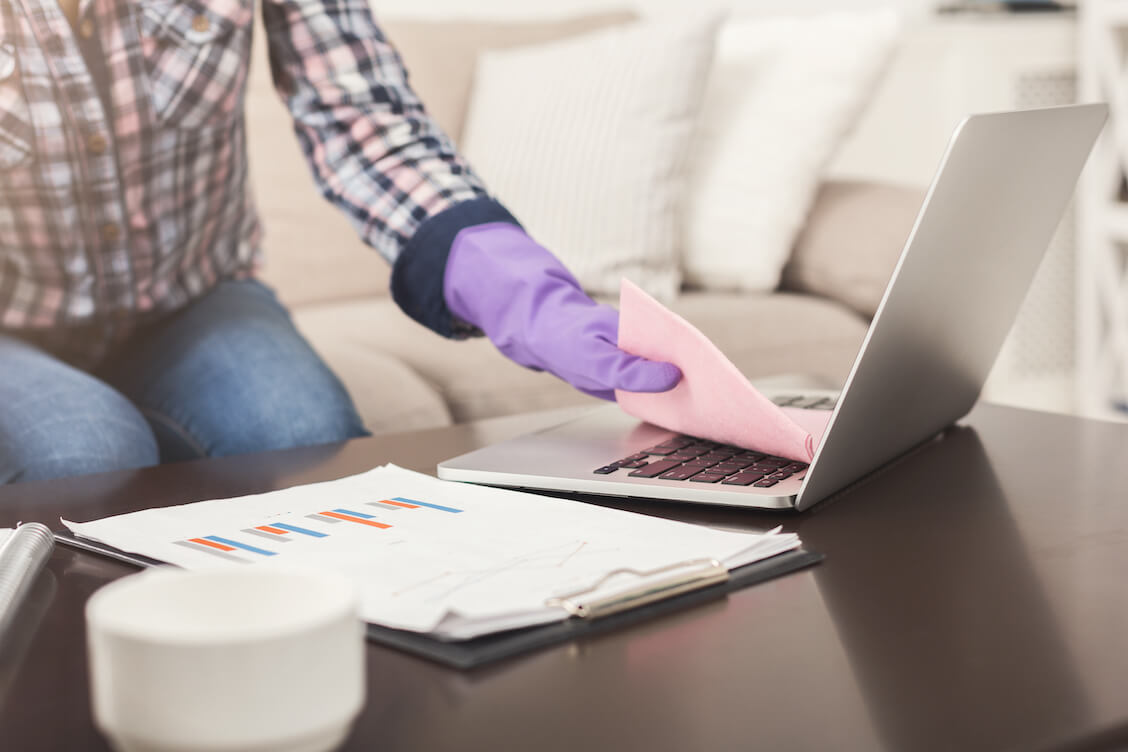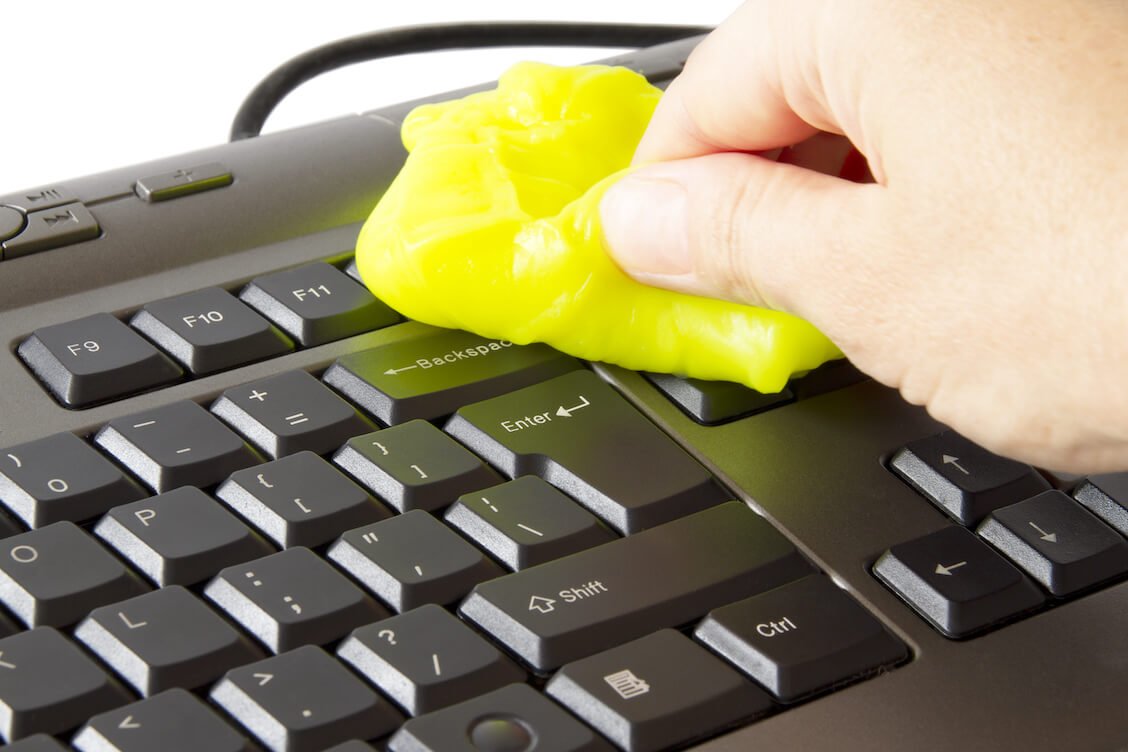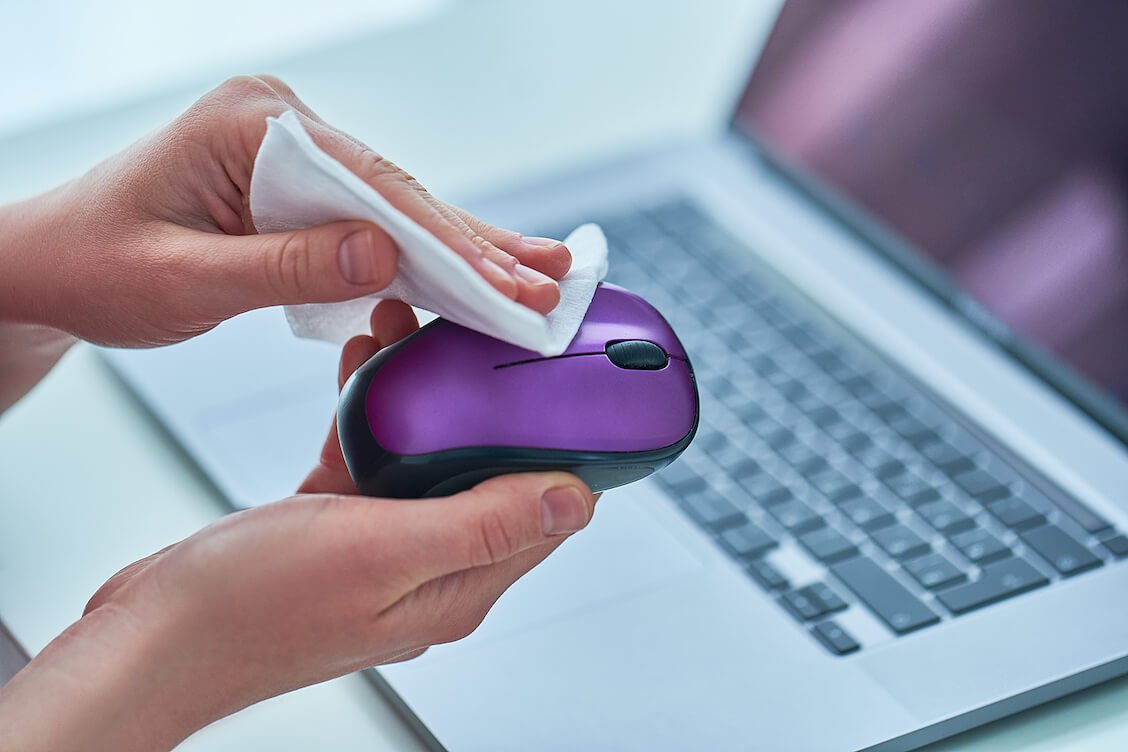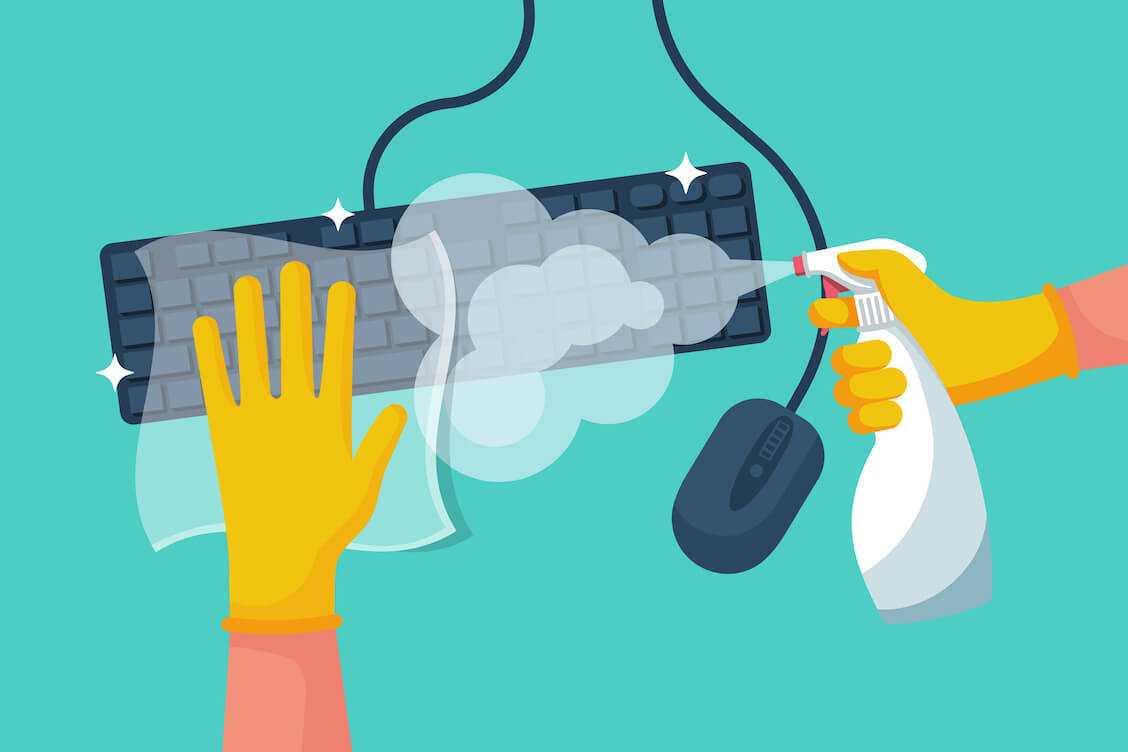- Essential Supplies for Cleaning Your Laptop Mouse and Keyboard
- Suitable Cleaning Solutions for Cleaning Laptop Mouse and Keyboard
- Preparing for Cleanup
- How to Clean Laptop Keyboard
- How to Dinsifenct Laptop Keyboard
- How to Clean a Mouse
- How to Clean Mouse Pad
- How to a Disinfect Laptop Mouse
- Precautions While Cleaning
- Conclusion
- FAQ
If you’re one of those people guilty of eating at your desk, you understand how dirty your laptop keyboard and mouse can get. With spills from coffee or soda, crumbs from pizza, or smudges from make-up or greasy fingers and pet hair, your laptop mouse and keyboard may use some TLC.
Frequently cleaning your mouse and keyboard removes dust, dirt, and grime that could potentially affect your laptop’s performance. But that’s not all. It also kills germs, the number of which, research shows, is 400 times higher on keyboards than on an average toilet seat!
Fortunately, you can easily clean and disinfect your laptop mouse and keyboard with some simple tools and techniques.
In this post, we share expert tips on:
- How to clean a mouse
- How to clean the mouse pad
- How to clean laptop keyboard
- How to disinfect laptop
Let’s get right into it!
Essential Supplies for Cleaning Your Laptop Mouse and Keyboard
Before we tell you how to disinfect a laptop, it’s important to prepare well by having all the necessary tools at hand. The good news is that most of these items are readily available around your home or at local stores.
So, what do you need to clean a laptop mouse and keyboard:
- Soft, lint-free cloths or microfiber cleaning cloths – these types of cloths will remove dust and dirt without scratching any surfaces.
- Isopropyl alcohol, also known as rubbing alcohol, is an effective cleaning agent that can handle sticky and unsightly messes.
- Cotton buds or Q-tips – these are perfect for cleaning hard-to-reach nooks and crannies of your keyboard and mouse.
- Anti-static cleaning wipes and brushes – these are particularly useful if static electricity buildup is a problem on your laptop.
- Keyboard cleaning gel – it does a great job of removing crud from between the keys of your keyboard.
- Compressed air or computer vacuum/blower – this will come in handy for blasting and dislodging stubborn debris from your mouse and keyboard.
Caution: Avoid using disinfecting wipes or any other products that contain bleach as this can damage the coating on plastic.
Now that you have all the supplies you need, it’s time to roll those sleeves up and get down to business!
Suitable Cleaning Solutions for Cleaning Laptop Mouse and Keyboard
When it comes to cleaning electronic devices, isopropyl alcohol is often the go-to solution. Its ability to effectively remove dirt and grime without leaving residue makes it a popular choice among tech enthusiasts.
However, isopropyl alcohol can be too harsh on some plastics, like those used in making a laptop mouse and keyboard.
Other alternatives worth considering include:
- A homemade solution made by diluting white vinegar with water in a 1:1 ratio. Vinegar, with its mild acidity, can effectively break down common stains and residues. Note that vinegar SHOULD NOT be used on touchscreens or LCDs as it can damage them.
- A water and soap solution is another good alternative. Make sure to use a mild soap like a liquid dish soap.
- For tougher stains that refuse to budge, a small amount of toothpaste can come to the rescue. Toothpaste, with its gentle abrasive properties, can help remove stubborn marks from electronic devices.
- Specialized electronic cleaning solutions are also effective alternatives. These solutions are specifically formulated to clean and protect electronic devices. They are designed to remove dirt, fingerprints, and smudges without causing any damage. You can find these products in most electronics stores and use them as a convenient option if you prefer ready-to-use solutions.
Preparing for Cleanup
There are a few precautions to take before you start cleaning:
- If you have any crucial data on your laptop, back it up – just in case. Learn how to back up files the right way.
- Shut down your laptop, unplug it from the power source, and remove the battery (if possible).
- Disconnect all cables, including for your mouse (if it’s not wireless).
- Remove any accessories attached to the laptop, such as external storage devices like a USB flash drive.
- Make sure you have sufficient space on your desk for cleaning your mouse and keyboard. Remember to be cautious when cleaning your laptop keyboard. They aren’t as easy to replace as desktop keyboards.
Related: How to Recover Deleted Files on Windows 10
How to Clean Laptop Keyboard
A dirty keyboard can hinder typing speed and accuracy, consequently affecting your productivity. Follow these steps to clean your laptop keyboard effectively:
Step 1: Have the tools ready
These include:
- A can of compressed air. A computer vacuum/blower does a better job.
- Microfiber cloth
- Isopropyl alcohol (70% concentration or higher)
- Cotton swabs
Step 2: Remove loose debris
Remember, your laptop should be turned off and all accessories and cables disconnected. To remove debris from your laptop keyboard, turn the laptop upside down and gently shake it. Do this over a trash bag so you don’t have to clean up later.
Next, use your can of compressed air to blast between the keys to get out as much dust and dirt as possible.
Important tip: While compressed air may work well, it has its downsides – it can blow the dust and crumbs further into your laptop, potentially causing more harm.
We recommend using a computer vacuum cleaner – a more efficient cleaning tool. Avoid using a household vacuum as it might be too powerful and end up vacuuming your keys or other components! You can purchase a micro vacuum attachment if you’re really serious about keyboard maintenance and care.
Step 3: Clean the keys

- Dampen the microfiber cloth in the cleaning solution. For this, you can mix equal parts of water and vinegar or water and isopropyl alcohol. Or, simply use a little water and mild soap (dish soap works best). The damp cloth should not be dripping wet. You don’t want liquid sipping into your keyboard.
- Gently wipe the keys, applying light pressure to remove any dirt or grime. For stubborn stains, try using a cotton swab dipped in rubbing alcohol. If the soft cloth isn’t doing the job, consider melamine cleaning sponges. They excel at cleaning grime and can last up to a year of reuse.
- Clean between the keys using a cotton swab moistened with isopropyl alcohol. Be gentle to avoid pressing the debris further into the keyboard. Repeat this process until the spaces between the keys are free from dirt.
Step 4: Clean underneath the keys
Debris under the keys can prevent some keys from working and could be the reason your PC randomly turns off. To avoid this, here’s how to clean under the laptop keyboard:
If your laptop allows it, you can carefully pry off the entire unit or individual keys and clean them using a damp soft cloth or sponge. Remember, don’t force your laptop keyboard to come off. Check the manufacturer’s manual if it’s designed to come off or not.
When in doubt, consult a professional to ensure the keyboard is removed and cleaned without damage.
If the keyboard or keys can’t come off, use a soft brush to gently clean any particles that may have been dislodged after using compressed air. Another effective product to use is a cleaning gel. Simply knead the goopy gel into a ball and gently press it into the keyboard.

Remove the gel, and you’ll be amazed at what it picks up. The gel is not only satisfying to use, it smells great and can be reused until it turns dark or becomes sticky.
Step 5: Allow the keyboard to dry
Once you’re done cleaning, let your laptop keyboard air dry for at least 30 minutes before turning your laptop back on. This will prevent potential damage to your keyboard caused by moisture.
Consider using a hairdryer on the lowest setting to speed up the drying process.
Related: Average Lifespan of a Laptop: Tips on How to Make it Last Longer
How to Dinsifenct Laptop Keyboard
Research published by the National Center for Biotechnology Information (NCBI) indicates that “76% out 75 keyboards were contaminated with bacteria and fungi.” To keep yours germ-free, consider disinfecting it regularly.
- First, make sure the laptop is switched off and disconnected from the power source and other external devices. Next, get a microfiber cloth and isopropyl alcohol.
- Spray the alcohol on the soft cloth and wipe down each key. Alternatively, use a cotton swab moistened with alcohol to clean every nook and cranny on your keyboard.
How to Clean a Mouse
Just like your keyboard, mouse cleaning requires a careful approach not to damage its sensitive components. If using a wired mouse, start by disconnecting it from your laptop to make cleaning easier.
The steps to clean a wireless mouse are similar to those of cleaning a wired mouse. Just be sure to remove the batteries (if applicable) and follow these steps:
Step 1: Cleaning the Mouse on the Inside
- Hold a can of compressed air, positioning the nozzle close to the gaps and openings of the mouse.
- Gently press the trigger, releasing short bursts of air. Watch as the dust particles dance in the air, leaving your mouse cleaner and more efficient.
- Next, Grab a soft-bristled brush, like a clean toothbrush or a small paintbrush, and lightly brush the surface of your mouse. Be careful not to apply too much pressure, as you don’t want to scratch or damage the mouse. The bristles will help dislodge any dirt or grime that may have accumulated over time.
Step 2: Cleaning the Mouse Surface

- Once the insides of the mouse are clean, it’s time to focus on the external, including the buttons and scroll wheel. These are the areas that receive the most contact and can easily accumulate dirt and oil from your fingers.
- Take a cotton swab and dip it in isopropyl alcohol or a mild cleaning solution. Gently rub the swab around the buttons, ensuring you reach all areas. This will help remove any stubborn residue and leave your mouse feeling fresh and responsive.
- Clean the mouse’s feet. Check the bottom of the mouse for rubber feet. Use a cotton swab dipped in the cleaning solution to clean the rubber, removing dirt buildup that can affect smooth gliding.
Grab a clean, lint-free cloth and gently pat the mouse to remove any excess moisture. Avoid using paper towels or tissues, as they can leave behind lint or fibers that may interfere with the mouse’s functionality.
How to Clean Mouse Pad
A clean mouse pad contributes significantly to the overall functionality and hygiene of your workspace. Not only does it enhance the accuracy and smoothness of your mouse movements, it ensures optimal performance and extended lifespan.
To clean your mouse pad:
- Start by removing any loose debris on the pad using an adhesive roller or a piece of sticky tape. This will help eliminate any dirt, dust, or hair that may have accumulated on the surface over time.
- Next, it’s time to tackle the surface of the mouse pad. You can use a mild detergent or soap and warm water to clean it. Fill a basin or sink with warm water and add a small amount of soap or detergent. Make sure to choose a gentle soap that won’t damage the material of your mouse pad.
- Dampen a sponge or cloth with the soap mixture and gently rub it onto the surface of the mouse pad. It’s important to avoid vigorous scrubbing as this can wear out the texture faster and potentially damage the pad. Instead, use a gentle circular motion to ensure an even and thoroughly cleaned mouse pad. Pay attention to any stubborn stains or areas that may require a bit more effort to clean.
- Next, rinse the mouse pad thoroughly under warm water, making sure to remove all traces of soap or detergent, as any residue left behind can affect the performance of your mouse.
- Allow the mouse pad to air dry completely before using it. Keep in mind that excess moisture can lead to the growth of mold and mildew, which can not only damage your mouse pad but also pose a health risk. To speed up the drying process, you can gently pat the mouse pad with a clean towel to remove any excess water and put it out to dry.
How to a Disinfect Laptop Mouse
Once you’ve cleaned your mouse, it’s good practice to further disinfect it to ensure the elimination of any harmful germs or bacteria. However, it’s critical to execute this step correctly to avoid causing more damage to your device.
There are a few methods you can employ to effectively disinfect your laptop mouse:
- Use disinfectant wipes specifically designed for electronic devices. When choosing wipes, make sure they are safe for electronics and do not contain any harsh chemicals that could potentially harm your mouse.
- Create your own disinfecting solution using a mixture of isopropyl alcohol and water. A 50/50 ratio is often recommended to strike the right balance between effectiveness and safety.
To disinfect the mouse, take a wipe or soft cloth damped by the isopropyl and water solution and wipe gently all areas of the mouse. Avoid excess moisture to protect the electronic circuitry.
Precautions While Cleaning
- Avoid using excessive amounts of water or liquid cleaning agents, as they may seep into the electronics and cause damage.
- Never spray cleaning solutions directly onto the laptop mouse or keyboard – always apply them to a cloth first.
- Be gentle when removing keycaps to avoid damaging them or the underlying mechanisms.
- Double-check that the laptop is powered off and disconnected from any power source before cleaning.
Conclusion
By following these expert tips on how to clean laptop mouse and keyboard, you can maintain a functional and hygienic working environment.
Remember, consistency is key! Set a schedule for cleaning and disinfecting your laptop mouse and keyboard, and you’ll enjoy a smoother, more enjoyable computing experience.
Cleaning your laptop shouldn’t stop there. Consider cleaning your Windows PC using safe and trusted software like Auslogics BoostSpeed. This tool performs a thorough cleansing of your system, removing all junk and optimizing it to ensure enhanced performance.
FAQ
How to Properly Disinfect a Laptop?
To properly disinfect a laptop, follow these steps:
- Turn off the laptop and unplug it from the power source.
- Use a soft, lint-free cloth slightly dampened with a mixture of isopropyl alcohol and water in equal parts.
- Gently wipe the surfaces of the laptop, including the keyboard, touchpad, and outer casing.
- Pay extra attention to high-touch areas, such as the keys and trackpad.
- Avoid excessive moisture and ensure the cloth is only slightly damp, not wet.
- Allow the laptop to air dry completely before turning it back on.
Also Read: Expert Tips on How to Clean a Computer
Is Using Clorox Wipes Bad for Keyboards?
Using Clorox wipes on keyboards is generally not recommended. Clorox wipes contain harsh chemicals that can damage the protective coating on the keys and cause them to fade or become sticky over time. It’s best to use a soft, lint-free cloth slightly dampened with a mixture of isopropyl alcohol and water to clean keyboards. Be sure to wring out the cloth well to avoid excessive moisture. You can also purchase Clorox wipes alternatives, which are safer.
Can I Use Disinfecting Wipes on a Monitor?
We do not recommend using disinfecting wipes directly on a monitor. Disinfecting wipes often contain chemicals that can damage the screen’s anti-glare coating or leave streaks. Instead, use a microfiber cloth slightly dampened with water or a screen-cleaning solution specifically designed for monitors. Gently wipe the screen in a circular motion, careful not to apply too much pressure.



